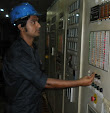Thermocouple
Thermocouple
Thermoelectric contact sensors are called thermocouples because at least two dissimilar conductors and two junctions (couples) of these conductors are needed to make a practical sensor. A thermocouple is a passive sensor.
 |
| Thermocouple |
 |
| Thermocouple |
For practical purposes, an application engineer must be concerned with three basic laws which establish the fundamental rules for proper connection of the thermocouples. It should be stressed, however, that an electronic interface circuit must always be connected to two identical conductors.
Law No. 1: A thermoelectric current cannot be established in a homogeneous circuit by heat alone.
Law No. 2: The algebraic sum of the thermoelectric forces in a circuit com-posed of any number and combination of dissimilar materials is zero if all junctions are at a uniform temperature.
Law No. 3: If two junctions at temperatures T1 and T2 produce Seebeck voltage V2, and temperatures T2 and T3 produce voltage V1, then temperatures T1 and T3 will produce V3 =V1 +V2.
Thermocouple Circuits
In the past, thermocouples were often used with a cold junction immersed into a reference melting ice bath to maintain its temperature at 0◦C (thus, the “cold” junction name). This presents serious limitations for many practical uses. The second and third thermoelectric laws allow for a simplified solution. A “cold” junction can be maintained at any temperature, including ambient, as long as that temperature is precisely known. Therefore, a “cold” junction is thermally coupled to an additional temperature sensor which does not require reference compensation. Usually, such a sensor is either thermo resistive or a semiconductor. Figure.B shows the correct connection of a thermocouple to an electronic circuit. Both the “cold” junction and the reference sensor must be positioned in an intimate thermal coupling. Usually, they are imbedded in a chunk of copper. To avoid dry contact, thermally conductive grease or epoxy should be applied for better thermal tracking.
Thermocouple Assemblies
A complete thermocouple sensing assembly generally consists of one or more of the following: a sensing element assembly (the junction), a protective tube (ceramic or metal jackets), a thermowell (for some critical applications, these are drilled solid bar stocks which are made to precise tolerances and are highly polished to inhibit corrosion), and terminations (contacts which may be in the form of a screw type, open type, plug and jack disconnect, military-standard-type connectors, etc.). Some typical thermocouple assemblies are shown in Fig. below.










